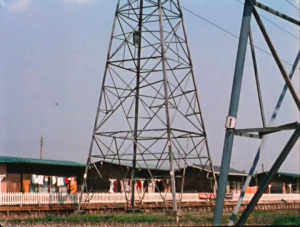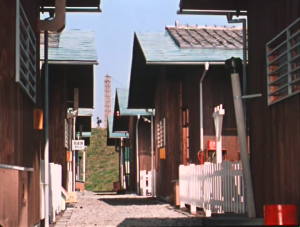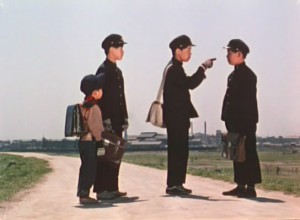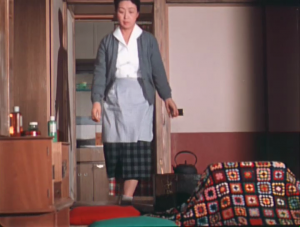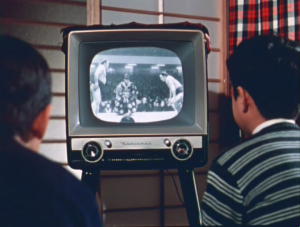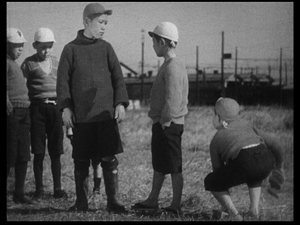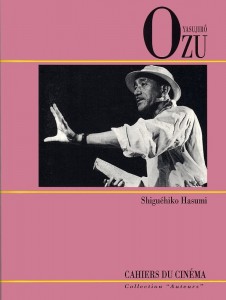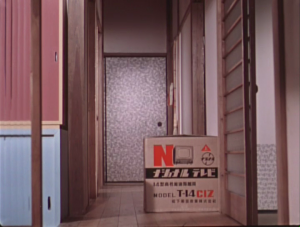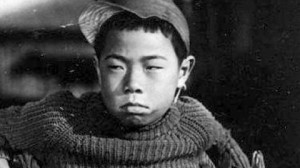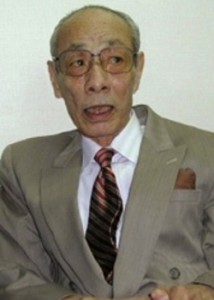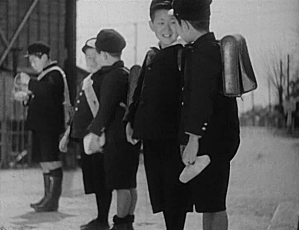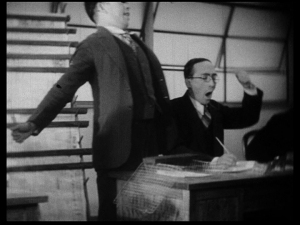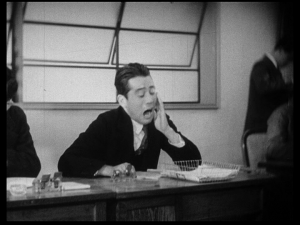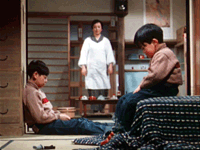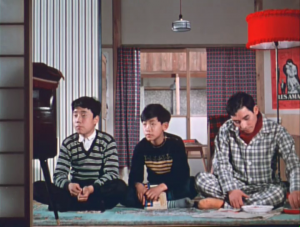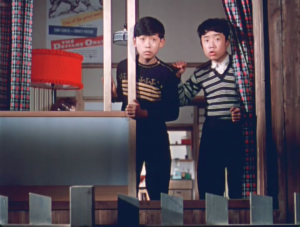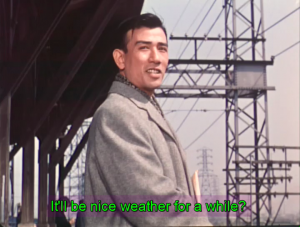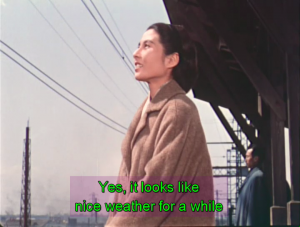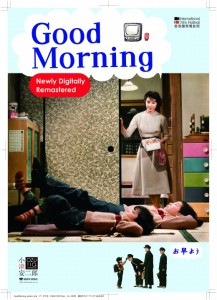Written for Criterion’s Blu-Ray release of Ozu’s Good Morning and I Was Born, But… in 2017. — J.R.
Structures and Strictures in Suburbia
Jonathan Rosenbaum
From its very opening, Good Morning is deeply and delightfully musical, both in its orchestrations of static visual elements in the first two shots (the juxtaposition of adjacent houses with fences and clotheslines, and all these horizontals with the verticality of electrical towers) and in its varying rhythmic patterns of human movement, which are no less orchestrated, as various figures cross the pathways between houses, between houses and hill, and on top of the hill itself—always, mysteriously, moving from right to left. And what could be more musical than the opening gag, occurring on the same sunny hilltop, of little boys farting for their own amusement, still another form of theme and variations?
All of which prompts me to disagree respectfully with the late Ozu specialist Donald Richie when he maintained, “Good Morning, in some ways Ozu’s most schematic film, certainly one of his least complicated formally, is an example of a film constructed around motifs.” Certainly the motifs are there, and these are vital; the two examined by Richie as sterling examples are the farting and the greeting embodied in the film’s title, and numerous variations are run on both. But as soon as one focuses on the relations between these two motifs—including the realization that the farting game is the boys’ way of saying “Good morning” to one another, and the fact that a housewife hears her husband’s farts in another room as if he were summoning her—the possibilities of comic and formal play deriving from this, at once satirical and musical, become endless; and they are far from simple.
In a broader sense, the standardization of suburban life that can lead a drunken neighbor to come home one night to the wrong house and also lead the neighborhood as a whole to ostracize a bohemian couple is a central motif in Good Morning, and this too has both formal and social implications—especially if one acknowledges that in Ozu, as in Jacques Tati, expressions of social forms and expressions of cinematic forms are simply two sides of the same coin. Because the society that Ozu depicts is essentially bound up in formality, it naturally follows that his sense of this society’s boundaries and limitations is intimately related to its ritual social gestures. He is gently critiquing these gestures– greetings and farts alike–at the same time he is both enjoying their absurdity and playing with their forms. And extending this playful principle, part of the unexpected brilliance of Good Morning (or Ohayo, as it’s called in Japanese) is how much formal ingenuity Ozu can exercise with visual “rhymes” in the riotous colors and identical square shapes (on quilts, other furnishings, clothes) of his scenic design, as if to refute or at least complicate the seeming monotony and replications of suburban neighborhoods.
Similarly, it’s remarkable how much complexity and universal wisdom he can find in the crosscutting patterns of a Japanese sitcom. Minoru and Isamu, aged respectively thirteen and seven, are chastised by their mother Tamiko for watching television (mainly sumo wrestling, a Japanese craze at the time) at the nearby house of the bohemian couple instead of attending their English lessons; their English teacher, currently jobless, is given translation work by their aunt, while their equally jobless neighbor Tomizawa complains to their father (Ozu standby Chishu Ryu) about the difficulty of being retired by his company. Meanwhile, there’s consternation about the disappearance of the local women’s club dues, and the fact that Mrs. Haraguchi (Haruko Sugimura, another Ozu regular), the treasurer, has recently bought a washing machine is the cause of some jealous suspicion, until the latter discovers that her mother has absentmindedly put the dues aside. This busy neighborhood interactivity, as conveyed through crosscutting that either contrasts or dovetails the separate intrigues, runs the gamut from trivial to profound and back again in such a way as to suggest how often serious and unserious matters can come to seem interchangeable—thanks to Ozu’s acute sense of form.
Ozu’s philosophical and formal equanimity, gauging both the significance and the inconsequentiality of everyday activities, is perfectly illustrated in the scene where Keitaro comes home to find his sons fretting because of Tamiko’s refusal to buy a TV. He says they talk too much and grows angrier when Minoru insists that grown-ups do the same, citing phrases like “Good morning” and “Fine day.” They retaliate by taking a vow of silence—a serious gesture, yet one that leads to diverse absurd consequences when it comes to dealing with neighbors and teachers.
Devoted to both the profound necessity and the sublime silliness of gratuitous social interchange, Good Morning is therefore much subtler and grander than it might initially appear to be. Commonly identified as a remake of Ozu’s silent masterpiece I Was Born, But…, also included in this edition, it is even more interesting for its differences than for its similarities—above all, the differences in what a father’s paternal authority means in prewar and postwar Japan. The focus of the earlier film is a family adapting to a new suburban neighborhood by undergoing brutal social initiations: the father humiliates himself before his boss to get ahead while the sons are accepted by their peers only after humiliating a local bully. Shocked by the behavior of their father, who insists that he has to demean himself in order to feed them, the sons retaliate by going on a hunger strike. In the much lighter and far from tragic climate of Good Morning, twenty-seven years later, the setting is again middle-class Tokyo suburbia, but the family is now firmly settled, and serious problems—old age, unemployment, ostracism—are principally reserved for their neighbors and friends. The sons’ complaint and rebellion are considerably milder. Significantly, it is the humiliations in the first film that provide much of the comedy, a subject assuming gravity only when it causes a rift between father and sons. But the more pervasive humor of Good Morning extends to the rebellion itself and all it engenders, as well as all the local intrigues surrounding it; one no longer feels that the father’s authority is a monument that can be toppled.
In his Critical Handbook of Japanese Film Directors, Alexander Jacoby notes that in spite of his obvious importance, “Ozu has nevertheless been represented in partial and misleading terms in many Western accounts.” Among the misunderstandings cited are the beliefs that Ozu “used an invariably static camera,” that his devout Zen Buddhism somehow accounts for everything in his films, and that he was “the most Japanese of Japanese directors.” But Ozu made almost twice as many silent pictures as talkies, and his early features abound in camera movements. Ozu ridiculed the assumption of some Westerners that his works could be explained by Zen, and as one of his sharpest and most insightful critics, Shigehiko Hasumi, has argued, he may have actually been the least Japanese of major Japanese directors. His worship of Hollywood movies, which persisted throughout most of his life, even extended to setting most of his own movies in the kind of clear and sunny weather you’re more likely to find in southern California than in the drizzly and overcast climate of his own country. Indeed, it can be argued that Ozu’s grasp of both reality and formality was tied to his sense of Hollywood studio filmmaking much more than some idea of Japanese “otherness.”
Lamentably, Hasumi’s book on Ozu remains unavailable in English apart from its closing chapter, pointedly titled “Sunny Skies”. But I think the best summary of what Hasumi has to offer to our Western misunderstandings of Ozu can be found in the following sentence: “Ozu’s talent lies in choosing an image that can function poetically at a particular moment by being assimilated into the film, not by affixing to the film the image of an object that is considered poetic in a domain outside the film.” In Good Morning, the poetic charge he can somehow muster out of an unopened carton containing a new TV set in a hallway is a perfect illustration of this principle—another example of making something mundane and familiar into something luminous and special thanks to its strategic placement in an edited sequence.
In the interests of full disclosure, I should note that my first visit to Japan, in late 1998, came at Hasumi’s invitation, during his stint as president of Tokyo University, to participate in a panel called “Yasujiro Ozu in the World” along with Hasumi himself, Hou Hsiao-hsien, his screenwriter Tien-wen Chu, and French critics Jean Douchet and Thierry Jousse. This was part of a retrospective and exhibition devoted to Ozu, and for me the most memorable feature of the latter was a display of notebooks kept by the filmmaker on each of his features. Emblematic of how meticulous he was as a control freak, he kept neat and precise records of precisely how long he anticipated each shot would last and then how long each shot actually did last. (Undoubtedly the most luminous moment of the panel was being approached in the lobby just afterwards by an elderly gentleman who spoke in Japanese to Hou and myself, shook our hands, and then walked away—a puzzling encounter that immediately, and appropriately, became explicated to me via mime, when Hou nimbly imitated the signature comic gesture of Tomio “Tokkankozo” Aoki, the younger son in I Was Born, But…—thus identifying the child actor discovered by Ozu and the title anti-hero of The Straightforward Boy, also included in this release, who went on to enjoy a screen career that would eventually last seventy-five years, encompassing even Seijun Suzuki’s 2001 Pistol Opera.)
One of the funniest gags in I Was Born, But… is possibly the most blatantly self-reflexive moment in Ozu’s oeuvre. Comparing the regimentation in the little boys’ school with the regimentation in their father’s office, Ozu shows the boys marching briskly past the camera in their schoolyard while the camera begins to track rapidly in the reverse direction. Then there is a cut to another rapid track in the father’s office, moving at the same speed past workers at a row of desks, some seated and some standing. Each worker yawns as if on cue just as the camera passes him, except for one, until the camera moves back, stops, and waits for him to yawn as well; as soon as he does, the camera resumes the same rapid movement past other workers, all of whom yawn on cue. This is a rather exceptional self-referential moment in Ozu’s work because it equates his own position of power as a director with the power of the state—specifically, with the power of the school and the office, the two principal zones of authority in the film apart from the more indeterminate zones of the field (ruled by the boys) and the house (ruled by the father).
Good Morning, of course, has its own ways of ironically comparing children and grownups, such as juxtaposing timid small talk between a youthful couple waiting for a train and the schoolboys’ farting game. (There is also an implicit comparison in the depiction of the adults’ childish envy when one household purchases a TV set and another one buys a new washing machine.) With a similar sense of scrupulous economy, there is the alternation of simply stated (if interlocking) miniplots with complex camera setups, less bound by narrative advancement, depicting the physical layout of the neighborhood itself: the perpendicular passageways between houses and the overhead road on the embankment behind all cogently suggesting certain structures as well as strictures in a society of interdependent yet insulated busybodies. In a context where sliding doors and shot changes become integral facets of the same “architecture”—an interrelating complex of adjacent, autonomous units—the fascination is how even throwaway details become part of the design. For instance, movie posters for The Defiant Ones and Louis Malle’s Les Amants, combined with various glimpses of the sumo wrestlers on TV, allude not only to the recalcitrant sons, but to a sense of antagonistic parties chained together by circumstance that often seems to function just below the surface of the everyday pleasantries. A grandmother muttering gripes in between her prayers, a drunken Tomizawa coming home to the wrong house, the young scat-singing couple being quietly hounded out of the community, a thoughtful Keitaro wondering if television will “produce 100 million idiots”: all these moments are characteristically uninflected, and each goes straight to the heart of the film.
Jonathan Rosenbaum, former film critic for the Chicago Reader (1987-2008), now maintains a website at jonathanrosenbaum.net archiving most of his work, including his writing on Ozu.

